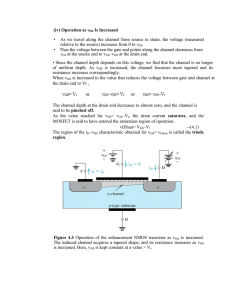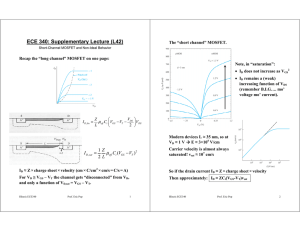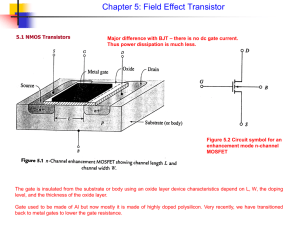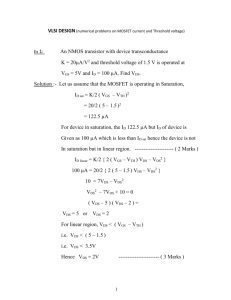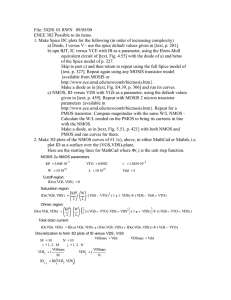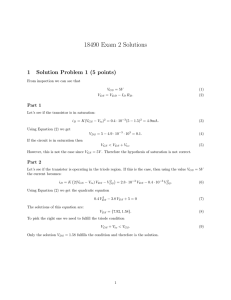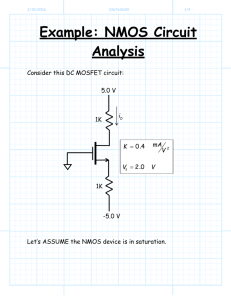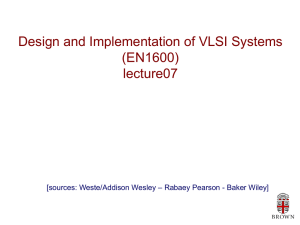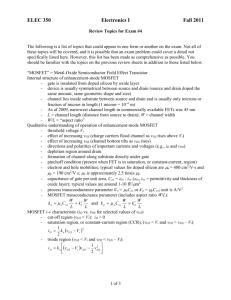L34_MOSFET
advertisement
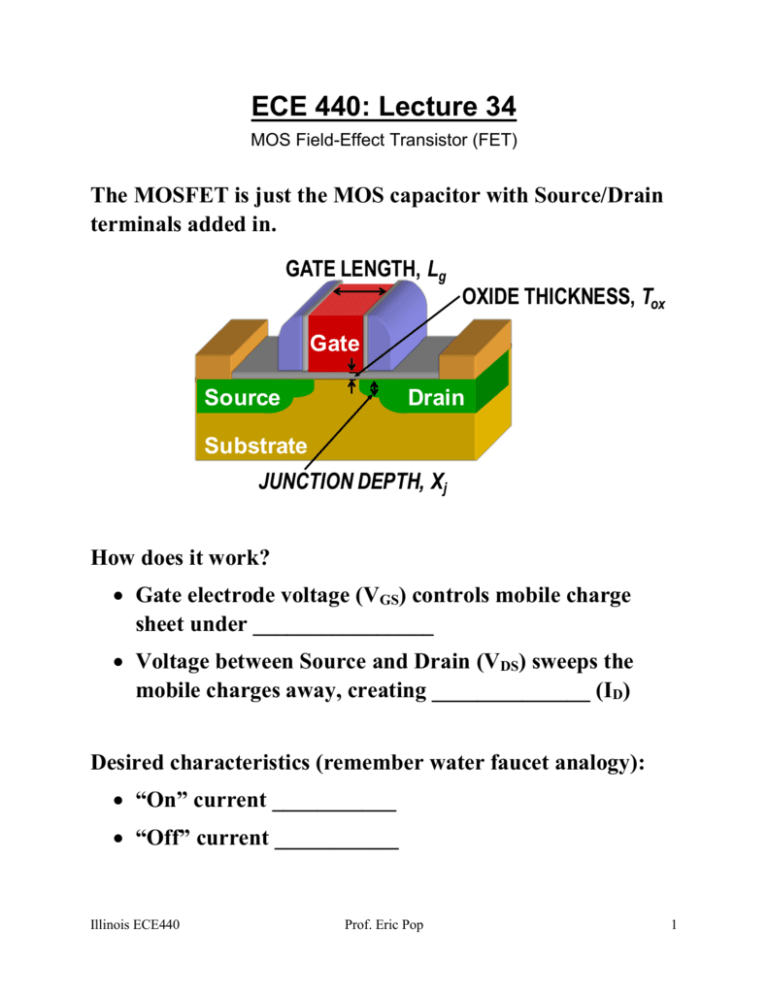
ECE 440: Lecture 34 MOS Field-Effect Transistor (FET) The MOSFET is just the MOS capacitor with Source/Drain terminals added in. GATE LENGTH, Lg OXIDE THICKNESS, Tox Gate Source Drain Substrate JUNCTION DEPTH, Xj How does it work? Gate electrode voltage (VGS) controls mobile charge sheet under ________________ Voltage between Source and Drain (VDS) sweeps the mobile charges away, creating ______________ (ID) Desired characteristics (remember water faucet analogy): “On” current ___________ “Off” current ___________ Illinois ECE440 Prof. Eric Pop 1 Typical 2-D cross-section view of NMOSFET: Note direction of carrier flow, and of current flow. Gate voltage (VG) controls Source-to-Drain current (ID). “Source” terminal refers to source of ______________ NMOS PMOS N+ poly-Si P+ poly-Si N+ P+ N+ P+ n-type Si P-type Si For current flow: Illinois ECE440 Prof. Eric Pop 2 Simplest CMOS circuit is the inverter: CIRCUIT SYMBOLS N-channel MOSFET P-channel MOSFET CMOS INVERTER CIRCUIT VDD VOUT S INVERTER LOGIC SYMBOL VDD D VIN D VOUT VIN S GND 0 VDD Note the PMOS and NMOS gates are tied together to VIN. So are the drains, to VOUT. When VIN = 0 then NMOS is _____ and PMOS is _____ When VIN = VDD then NMOS is _____ and PMOS is _____ Illinois ECE440 Prof. Eric Pop 3 Theory of MOSFET: When VGS < VT the channel is ______________ depletion layer When VGS > VT the channel is ______________ If small drain voltage (VD > 0) is applied _______________ Will charge sheet move by drift or diffusion? Current ≈ width × charge sheet × velocity What is the inversion charge: |Qinv| ≈ What is the velocity: v ≈ Illinois ECE440 Prof. Eric Pop 4 At low VDS inversion layer essentially acts like a resistor! I DS WQinvv WCox VG VT eff VDS V G T eff L WC V ox What about higher drain voltages VDS? Must take into account variation of potential along channel, 0 < Vx < VDS. So inversion layer charge at any point is |Qinv(x)| = Cox(VGS – VT – Vx) And the current is: IDS,lin = VDS W eff Cox VGS VT VDS L 2 Still linear in voltage! This is the linear region. When VDS = VGS – VT the channel becomes _____________ Illinois ECE440 Prof. Eric Pop 5 When VDS > VGS - VT the un-inverted (drain depletion) region increases, as does the ____________________ Any increase in VDS: Reduces the amount of inversion charge, but… Increases the lateral field (charge velocity) The two effects cancel each other out, so at high VDS the drain current is no longer a function of VDS! The current saturates to a value only dependent on VGS (i.e. charge). Putting in VDS = VGS – VT (the pinch-off, i.e. saturation condition) in the previous equation: I DS , sat Illinois ECE440 1W eff Cox (VGS VT ) 2 2 L Prof. Eric Pop 6 Plot and label an example NMOSFET: What about IDS vs. gate voltage (VGS)? Illinois ECE440 Prof. Eric Pop 7 What is the “effective mobility” μeff in the channel? Can we go look it up in the bulk-silicon charts? (Vgs + V t + 0.2)/6Toxe (MV/cm) (NFET) (PFET) –(Vgs + 1.5V t – 0.25)/6Tox e (MV/cm) Scattering mechanisms affecting mobility in channel: Charged impurity (Coulomb) scattering Lattice vibration (phonon) scattering Surface roughness scattering Illinois ECE440 Prof. Eric Pop 8
